Related Research Articles

The coyote is a species of canine native to North America. It is smaller than its close relative, the gray wolf, and slightly smaller than the closely related eastern wolf and red wolf. It fills much of the same ecological niche as the golden jackal does in Eurasia. The coyote is larger and was once referred to as the American jackal by a behavioral ecologist. Other historical names for the species include the prairie wolf and the brush wolf.

Canidae is a biological family of dog-like carnivorans, colloquially referred to as dogs, and constitutes a clade. A member of this family is also called a canid. The family includes three subfamilies: the Caninae, the extinct Borophaginae and Hesperocyoninae. The Caninae are known as canines, and include domestic dogs, wolves, coyotes, foxes, jackals and other species.

There are 38 subspecies of Canis lupus listed in the taxonomic authority Mammal Species of the World. These subspecies were named over the past 250 years, and since their naming, a number of them have gone extinct. The nominate subspecies is the Eurasian wolf.
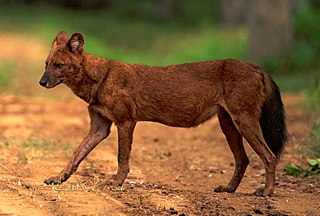
The dhole is a canid native to Central, South, East and Southeast Asia. It is genetically close to species within the genus Canis, but distinct in several anatomical aspects: its skull is convex rather than concave in profile, it lacks a third lower molar and the upper molars possess only a single cusp as opposed to between two and four. During the Pleistocene, the dhole ranged throughout Asia, with its range also extending into Europe but became restricted to its historical range 12,000–18,000 years ago.
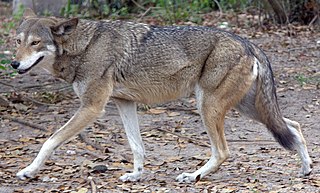
The red wolf is a canine native to the southeastern United States. Its size is intermediate between the coyote and gray wolf.

The dingo is an ancient (basal) lineage of dog found in Australia. Its taxonomic classification is debated as indicated by the variety of scientific names presently applied in different publications. It is variously considered a form of domestic dog not warranting recognition as a subspecies, a subspecies of dog or wolf, or a full species in its own right.
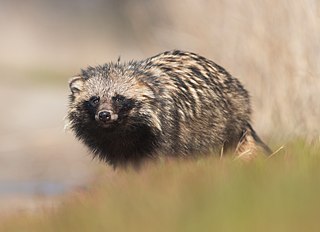
The common raccoon dog, also called the Chinese or Asian raccoon dog to distinguish it from the Japanese raccoon dog, is a small, heavy-set, fox-like canid native to East Asia. Named for its raccoon-like face markings, it is most closely related to foxes. Common raccoon dogs feed on many animals and plant matter, and are unusual among canids in that they hibernate during cold winters and can climb trees. They are widespread in their native range, and are invasive in Europe where they were introduced for the fur trade. The similar Japanese raccoon dog, native to Japan, is the only other living member of the genus Nyctereutes. Other names for the common raccoon dog include mangut, and neoguri.

The culpeo, also known as culpeo zorro, Andean zorro, Andean fox, Paramo wolf, Andean wolf, and colpeo fox, is a species of South American fox. Despite the name, it is not a true fox, but more closely related to wolves and jackals. Its appearance resembles that of foxes due to convergent evolution.

The maned wolf is a large canine of South America. It is found in Argentina, Brazil, Bolivia, Peru, and Paraguay, and is almost extinct in Uruguay. Its markings resemble those of foxes, but it is neither a fox nor a wolf. It is the only species in the genus Chrysocyon.
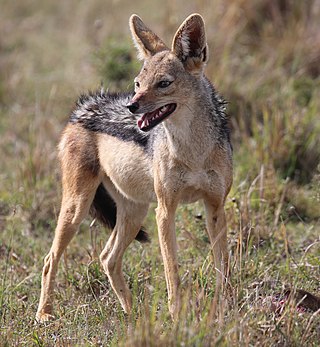
The black-backed jackal, also called the silver-backed jackal, is a medium-sized canine native to eastern and southern Africa. These regions are separated by roughly 900 kilometers.

The golden jackal, also called common jackal, is a wolf-like canid that is native to Eurasia. The golden jackal's coat varies in color from a pale creamy yellow in summer to a dark tawny beige in winter. It is smaller and has shorter legs, a shorter tail, a more elongated torso, a less-prominent forehead, and a narrower and more pointed muzzle than the Arabian wolf. It is listed as Least Concern on the IUCN Red List due to its widespread distribution and high density in areas with plenty of available food and optimum shelter.

The New Guinea singing dog or New Guinea Highland dog is an ancient (basal) lineage of dog found in the New Guinea Highlands, on the island of New Guinea. Once considered to be a separate species in its own right, under the name Canis hallstromi, it is closely related to the Australian dingo. The dog is relatively unusual among canines; it is one of the few to be considered "barkless", and is known for the unusual "yodel"-like style of vocalizing that gives it its name.

The side-striped jackal is a canine native to central and southern Africa.

The Great Plains wolf, also known as the buffalo wolf or loafer, is a subspecies of gray wolf that once extended throughout the Great Plains, from southern Manitoba and Saskatchewan in Canada southward to northern Texas in the United States. The subspecies was thought to be extinct in 1926, until studies declared that its descendants were found in Minnesota, Wisconsin and Michigan. They were described as a large, light-colored wolf but with black and white varying between individual wolves, with some all white or all black. The Native Americans of North Dakota told of how only three Great Plains wolves could bring down any sized bison.
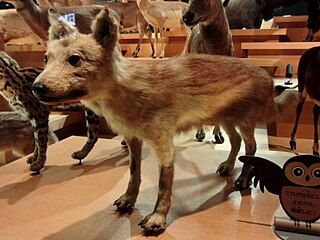
The Japanese wolf, also known as the Honshū wolf, is an extinct subspecies of the gray wolf that was once endemic to the islands of Honshū, Shikoku and Kyūshū in the Japanese archipelago.

The Himalayan wolf is a canine of debated taxonomy. It is distinguished by its genetic markers, with mitochondrial DNA indicating that it is genetically basal to the Holarctic grey wolf, genetically the same wolf as the Tibetan and Mongolian wolf, and has an association with the African wolf. No striking morphological differences are seen between the wolves from the Himalayas and those from Tibet. The Himalayan wolf lineage can be found living in Ladakh in the Himalayas, the Tibetan Plateau, and the mountains of Central Asia predominantly above 4,000 m (13,000 ft) in elevation because it has adapted to a low-oxygen environment, compared with other wolves that are found only at lower elevations.

In the taxonomic treatment presented in the third (2005) edition of Mammal Species of the World, Canis lupus dingo is a taxonomic rank that includes both the dingo that is native to Australia and the New Guinea singing dog that is native to the New Guinea Highlands. It also includes some extinct dogs that were once found in coastal Papua New Guinea and the island of Java in the Indonesian Archipelago. In this treatment it is a subspecies of Canis lupus, the wolf, although other treatments consider the dog as a full species, with the dingo and its relatives either as a subspecies of the dog, a species in its own right, or simply as an unnamed variant or genetic clade within the larger population of dogs. The genetic evidence indicates that the dingo clade originated from East Asian domestic dogs and was introduced through the Malay Archipelago into Australia, with a common ancestry between the Australian dingo and the New Guinea singing dog. The New Guinea singing dog is genetically closer to those dingoes that live in southeastern Australia than to those that live in the northwest.

The Paleolithic dog was a Late Pleistocene canine. They were directly associated with human hunting camps in Europe over 30,000 years ago and it is proposed that these were domesticated. They are further proposed to be either a proto-dog and the ancestor of the domestic dog or an extinct, morphologically and genetically divergent wolf population.

The evolution of the wolf occurred over a geologic time scale of at least 300 thousand years. The grey wolf Canis lupus is a highly adaptable species that is able to exist in a range of environments and which possesses a wide distribution across the Holarctic. Studies of modern grey wolves have identified distinct sub-populations that live in close proximity to each other. This variation in sub-populations is closely linked to differences in habitat – precipitation, temperature, vegetation, and prey specialization – which affect cranio-dental plasticity.
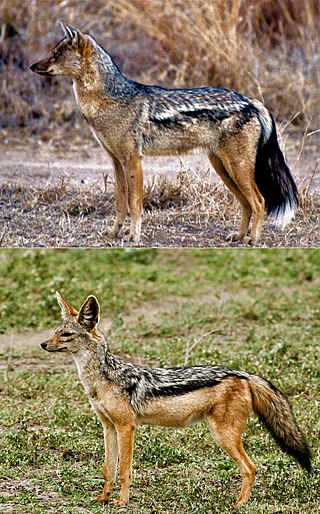
Lupulella is a genus of canine found in Africa. This genus consists of only two extant species, the black-backed jackal and the side-striped jackal.
References
- ↑ Busch, Robert (August 1, 2007). Wolf Almanac, New and Revised: A Celebration Of Wolves And Their World. Rowman & Littlefield. p. 13. ISBN 978-1461749714.
- ↑ Heuvelmans, Bernard (1995). On the track of unknown animals. London New York: Routledge. p. 31-32. ISBN 978-1-317-84811-0. OCLC 958102058.
- ↑ Krumbiegel, I. von. 1949. Der Andenwolf-ein neuentdecktes Grosstier. Unschau Wiss. Tech., vol. 19, pp. 590-591.
- ↑ Krumbiegel, I. von. 1953. Der "Andenwolf', Dasycyon hagenbecki (Krumbeigel, 1949). Saugetierk. Mitt., vol. 1, pp. 97-104.
- ↑ Stains, Howard J. 1967. Carnivores and pinnipeds. In S. Anderson and J. K. Jones (eds.), Recent mammals of the world, a synopsis of families. New York, The Ronald Press Co., pp. 325-354.
- ↑ Stains, Howard J. 1975. Distribution and taxonomy of the Canidae. In M. W. Fox (ed.), The wild canids, their systematics, behavioral ecology and evolution. New York, Van Nostrand Reinhold Co., pp. 3-26
- 1 2 Van Gelder, Richard G. (April 21, 1978). "A Review of Canid Classification" (PDF). American Museum Novitates (2646). The American Museum of Natural History: 2.
- ↑ Shuker, Karl (2002). The new zoo : new and rediscovered animals of the twentieth century. Thirsk: House of Stratus. p. 54. ISBN 978-1-84232-561-2. OCLC 59531459.
- 1 2 Eberhart, George (2002). Mysterious creatures : a guide to cryptozoology. Santa Barbara, Calif: ABC-CLIO. p. 17-18. ISBN 978-1-57607-283-7. OCLC 50562074.